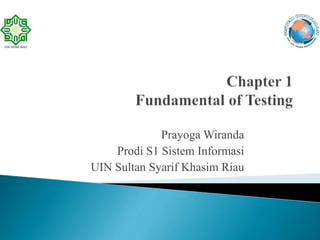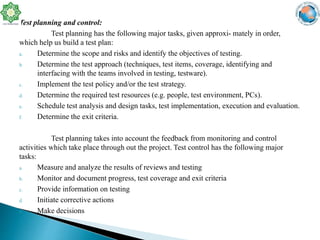Bab i fundamental of testing (yoga)
- 1. Prayoga Wiranda Prodi S1 Sistem Informasi UIN Sultan Syarif Khasim Riau
- 2. Recall the fundamental test activities from planning to test closure activities and the main tasks of each test activity. (K1) Introduction: These start with test planning and continue through to test closure. In this section, you'll also encounter the glossary terms confirmation testing, exit criteria, incident, regression testing, test basis, test condition, test coverage, test data, test execution, test log, test plan, test strategy, test summary report and testware. So we can divide the activities within the fundamental test process into the following basic steps: a. planning and control; b. analysis and design; c. implementation and execution; d. evaluating exit criteria and reporting; e. test closure activities. This process is par- ticularly used for dynamic testing, but the main headings of the process can be applied to reviews as well.
- 3. Test planning and control: Test planning has the following major tasks, given approxi- mately in order, which help us build a test plan: a. Determine the scope and risks and identify the objectives of testing. b. Determine the test approach (techniques, test items, coverage, identifying and interfacing with the teams involved in testing, testware). c. Implement the test policy and/or the test strategy. d. Determine the required test resources (e.g. people, test environment, PCs). e. Schedule test analysis and design tasks, test implementation, execution and evaluation. f. Determine the exit criteria. Test planning takes into account the feedback from monitoring and control activities which take place through out the project. Test control has the following major tasks: a. Measure and analyze the results of reviews and testing b. Monitor and document progress, test coverage and exit criteria c. Provide information on testing d. Initiate corrective actions e. Make decisions
- 4. Test analysis and design: Test analysis and design has the following major tasks, in approximately the following order: a. Review the test basis (such as the product risk analysis, requirements, architecture, design specifications, and interfaces), examining the specifications for the software we are testing. b. Identify test conditions based on analysis of test items, their specifications, and what we know about their behavior and structure. c. Design the tests using techniques to help select representative tests that relate to particular aspects of the soft ware which carry risks or which are of particular interest, based on the test conditions and going into more detail. d. Evaluate testability of the requirements and system. e. Design the test environment set-up and identify any required infrastructure and tools.
- 5. Test implementation and execution: Test implementation and execution have the following major tasks, in approximately the following order: Implementation: a. Develop and prioritize test cases b. Create test suites from the test cases for efficient test execution. c. Implement and verify the environment. Execution: a. Execute the test suites and individual test cases, following test procedures. b. Log the outcome of test execution and record the identities and versions of the software under test, test tools and testware. c. Compare actual results (what happened when we ran the tests) with expected results (what we anticipated would happen). d. Where there are differences between actual and expected results, report discrepancies as incidents. e. Repeat test activities as a result of action taken for each discrepancy.
- 6. Evaluating exit criteria and reporting: Evaluating exit criteria has the following major tasks: a. Check test logs against the exit criteria specified in test planning. b. Assess if more tests are needed or if the exit criteria specified should be changed. c. Write a test summary report for stakeholders Test closure activities: a. Test closure activities include the following major tasks b. Check which planned deliverables we actually delivered and ensure all incident reports have been resolved through defect repair or deferral. c. Finalize and archive testware, such as scripts, the test environment, and any other test infrastructure, for later reuse. d. Hand over testware to the maintenance organization who will support the software and make any bug fixes or maintenance changes, for use in con firmation testing and regression testing. e. Evaluate how the testing went and analyze lessons learned for future releases and projects.
- 7. 1. A company recently purchased a commercial off-the- shelf application to automate their bill-paying process. They now plan to run an acceptance test against the package prior to putting it into production. Which of the following is their most likely reason for testing? a. To build confidence in the application. b. To detect bugs in the application. c. To gather evidence for a lawsuit. d. To train the users.
- 8. 2. According to the ISTQB Glossary, the word 'bug' is synonymous with which of the following words? a. Incident b. Defect c. Mistake d. Error 3. According to the ISTQB Glossary, a risk relates to which of the following? a. Negative feedback to the tester b. Negative consequences that will occur c. Negative consequences that could occur d. Negative consequences for the test object
- 9. 4. Ensuring that test design starts during the requirements definition phase is important to enable which of the following test objectives? a. Preventing defects in the system. b. Finding defects through dynamic testing. c. Gaining confidence in the system. d. Finishing the project on time. 5. According to the ISTQB Glossary, regression testing is required for what purpose? a. To verify the success of corrective actions. b. To prevent a task from being incorrectly considered completed. c. To ensure that defects have not been introduced by a modification. d. To motivate better unit testing by the programmers.
- 10. Graham, D., et al.2006.Foundations of Software Testing : ISTQB Certification.London, UK :International Thomson Business Press http://sif.uin-suska.ac.id/ http://fst.uin-suska.ac.id/ http://uin-suska.ac.id/









